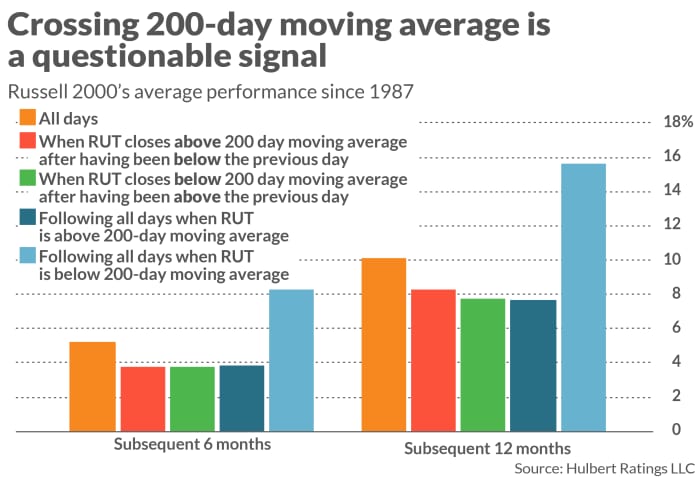This post was originally published on this site
CHAPEL HILL, N.C. — Small-cap stocks have not entered into a bear market.
That’s worth emphasizing because last week the Russell 2000 index closed below its 200-day moving average, after having been above it for several months. Many stock-market technicians believe that breaking the 200-day moving average indicates that the major trend could be shifting from bullish to bearish.
The Russell 2000’s
RUT,
IWM,
history does not support that belief. On average over the last four decades, the index has performed no worse than average following such signals.
Take what happened last Sept. 23, when this small-cap benchmark closed below its 200-day moving average after having been above it for several months prior. Far from continuing to decline, the index responded to this bear-market signal by rallying strongly. It is today more than 50% higher than where it was then.
Something similar might be taking place this time around as well. Since violating its 200-day moving average last week, the Russell 2000 index has rallied strongly—and is now more than 3% higher.
To be sure, these recent experiences constitute anecdotal rather than rigorous statistical evidence. But they are consistent with the historical record.
This chart plots how the Russell 2000 performed since 1987 following days on which it closed below its 200-day moving average, after having been above it the day prior. On average over the subsequent six months, the index gained 3.75%. That’s almost identical to the average six-month gain of 3.78% following days that are just the opposite—days when the Russell 2000 closed above its 200-day moving average after having been below it the day before.

The difference at the 12-month horizon is slightly larger: An average gain of 7.73% following first closes below the 200-day moving average, versus 8.31% following first closes above. However, even this difference is not significant at the 95% confidence level that statisticians often use when determining whether a pattern is genuine.
Far bigger differences emerge when we compare all days after the Russell 2000 has moved above its moving-day average with all days after it has crossed below. In this case, the index’s performance is much larger when it’s below rather than above the moving average. That’s just the opposite of what’s presumed by the conventional wisdom.
The same is true for the S&P 500
You shouldn’t be surprised by what I found for the Russell 2000 index since it’s consistent with what’s true also for the S&P 500 index
SPX,
Consider an extensive study conducted a number of years ago by a research intern in my office. He calculated the performance since the mid-1920s of trading rules for the S&P 500 based on the 200-day average, under a number of different assumptions—and came up empty.
For example, he found that, with realistic assumptions, a trading strategy based on the 200-day moving average failed to beat a buy-and-hold approach for many of the decades from the 1920s through the 1980s. Beginning in the 1990s, it lagged even under the most favorable of assumptions.
Be careful how you put these findings into practice. Bear in mind that a bear market could begin at any time. The results presented here just mean that, if a bear market does begin in coming days, it won’t be because the Russell 2000 index last week broke below 200-day moving average.
Mark Hulbert is a regular contributor to MarketWatch. His Hulbert Ratings tracks investment newsletters that pay a flat fee to be audited. He can be reached at mark@hulbertratings.com.


